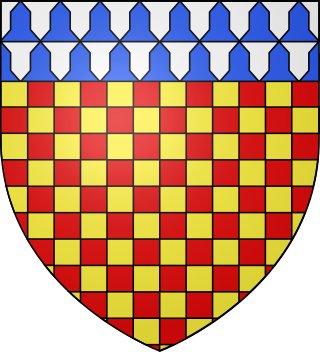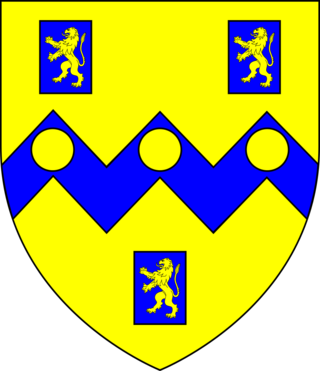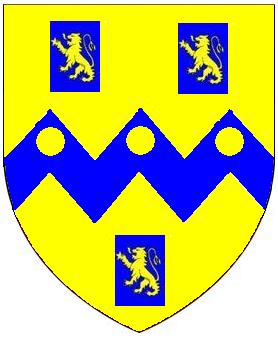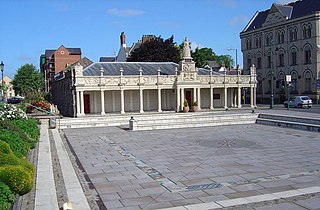
Arthur Champneys (c. 1658-1724) of Raleigh House in the parish of Pilton, Devon, and of Love Lane in the City of London, England, was a wealthy merchant and a Member of Parliament for Barnstaple (near Pilton), in Devon, from 1690 to 1705. [2]

Arthur Champneys (c. 1658-1724) of Raleigh House in the parish of Pilton, Devon, and of Love Lane in the City of London, England, was a wealthy merchant and a Member of Parliament for Barnstaple (near Pilton), in Devon, from 1690 to 1705. [2]
Sign at entrance to today's "Cogworthy Farm", anciently the mansion house of "Cockworthy", seat of the de Cockworthy family, lords of the manor of Yarnscombe [3] and later of the Champneys family]] He was a younger son of John Champneys (1605-1681) of Cockworthy (today "Cogworthy" Farm) in the parish of Yarnscombe, Devon, educated at Oxford University, whose mural monument formerly existed in Yarnscombe Church, [4] by his second wife Anne Upton, 3rd daughter of John Upton (1590-1641) of Lupton in the parish of Brixham, Devon, an MP for Dartmouth in Devon. Anne's mother was Dorothy Rous (or Rowse) (d. 1644), a daughter of Sir Anthony Rous (c. 1555-1620), MP, of Halton Barton (one of Cornwall's richest residents [5] ) and sister of Francis Rous (1579-1659), MP and theologian. [6]
Champneys' election as one of the two MPs for Barnstaple was due to his having in 1689 purchased the important manor of Raleigh [7] in the parish of Pilton, adjoining the town of Barnstaple, from Sir Arthur Chichester, 3rd Baronet, whom he succeeded as MP for Barnstaple in 1690. The manor of Raleigh controlled the electorate of at least one seat within the Rotten Borough, and until 1566 the Chichester family had been lords of the manor of "Barnstaple Castle Manor" or "Castle Court". [8] In 1703 Champneys sold Raleigh to Sir Nicholas Hooper (1654–1731), his fellow MP for Barnstaple in 1701. [9]
He married Hannah Ingram (1673-1693), a daughter of Sir Arthur Ingram (1617-1681), of the parish of St. Andrew's, Holborn, City of London, and of Bucknall, [10] Lincolnshire, knight, a merchant, a Citizen of the City of London and a member of the Spanish Company, which was very active in Barnstaple. One of her sisters Anne Ingram married Nathaniel Herne (1668-1722), MP for Dartmouth 1699-1713 and nephew of Sir Joseph Herne, [11] Governor of the East India Company 1690–2. [12] Another of her sisters Philadelphia Ingram married a son of Sir Robert Barnham, 1st Baronet (MP Maidstone, 1660, 1661–79). [13] Hannah died aged 20, leaving one daughter. [14]
He died in 1724 in London and was buried on 2 April 1724 at the Church of St Dionis Backchurch (demolished 1878) in the City of London. [10] The large mural monument to his father-in-law in the chancel of that church made reference to him as follows: [15]

Arlington was a manor, and is a village and civil parish in the North Devon district of Devon in England. The parish includes the villages of Arlington and Arlington Beccott. The population of the parish is 98.

Eggesford is a parish in mid-Devon, without its own substantial village. It is served by Eggesford railway station on the Exeter to Barnstaple railway line, also known as the Tarka Line.

There have been three baronetcies created for persons with the surname Chichester, one in the Baronetage of England and two in the Baronetage of the United Kingdom. Only the 1641 creation is extant.

Sir John Chichester, 1st Baronet lord of the manor of Raleigh in the parish of Pilton in Devon, was an English landowner and politician who sat in the House of Commons from 1661 to 1667.

Sir John Chichester (1519/20-1569) of Raleigh in the parish of Pilton, near Barnstaple in North Devon, was a leading member of the Devonshire gentry, a naval captain, and ardent Protestant who served as Sheriff of Devon in 1550-1551, and as Knight of the Shire for Devon in 1547, April 1554, and 1563, and as Member of Parliament for Barnstaple in 1559, over which borough his lordship of the manor of Raleigh, Pilton had considerable influence.

Sir Arthur Bassett (1541–1586) was a member of the prominent west-country Basset family and was MP for Barnstaple in 1563 and Devon in 1572. He served as JP for Devon from 1569 to his death and as Sheriff of Devon in 1574–5. He was knighted in 1575. He had been appointed deputy warden of Stannaries by 1580.

George Rolle of Stevenstone in the parish of St Giles in the Wood near Great Torrington in Devon, was the founder of the wealthy, influential and widespread Rolle family of Devon, which according to the Return of Owners of Land, 1873 in the person of Hon. Mark Rolle, the adoptive heir of John Rolle, 1st Baron Rolle, had become by that year the largest landowner in Devon with about 55,000 acres. He was a Dorset-born London lawyer who in 1507 became Keeper of the Records of the Court of Common Pleas and was elected as a Member of Parliament for Barnstaple in 1542 and 1545. He became the steward of Dunkeswell Abbey in Devon, and following the Dissolution of the Monasteries he purchased much ex-monastic land in Devon. Not only was he the founder of his own great Devonshire landowning dynasty but he was also an ancestor of others almost as great, including the Acland baronets of Killerton, the Wrey Baronets of Tawstock and the Trefusis family of Trefusis in Cornwall now of Heanton Satchville, Huish, later Baron Clinton, heirs both of Rolle of Heanton Satchville, Petrockstowe and of Rolle of Stevenstone.

The historic manor of Raleigh, near Barnstaple and in the parish of Pilton, North Devon, was the first recorded home in the 14th century of the influential Chichester family of Devon. It was recorded in the Doomsday Book of 1086 together with three other manors that lie within the later-created parish of Pilton. Pilton as a borough had existed long before the Norman Conquest and was one of the most important defensive towns in Devon under the Anglo-Saxons. The manor lies above the River Yeo on the southern slope of the hill on top of which exists the ruins of the Anglo-Saxon hillfort of Roborough Castle. The historic manor of Raleigh is now the site of the North Devon District Hospital.

Sir John Chichester, 4th Baronet of Youlston Park in the parish of Shirwell near Barnstaple, Devon was a British landowner and Tory politician who sat in the House of Commons from 1734 to 1740.

Shirwell is a village, civil parish and former manor in the local government district of North Devon, in the county of Devon, England. It was also formerly the name of a hundred of Devon. The village lies about 3.5 miles north-east of the town of Barnstaple, to the east of the A39 road to Lynton. The parish is surrounded clockwise from the north by the parishes of East Down, Arlington, Loxhore, Bratton Fleming, Goodleigh, Barnstaple, West Pilton and Marwood. In 2001 its population was 333, little changed from the 1901 figure of 338.

Hall is a large estate within the parish and former manor of Bishop's Tawton, Devon. It was for several centuries the seat of a younger branch of the prominent and ancient North Devon family of Chichester of Raleigh, near Barnstaple. The mansion house is situated about 2 miles south-east of the village of Bishop's Tawton and 4 miles south-east of Barnstaple, and sits on a south facing slope of the valley of the River Taw, overlooking the river towards the village of Atherington. The house and about 2,500 acres of surrounding land continues today to be owned and occupied by descendants, via a female line, of the Chichester family. The present Grade II* listed neo-Jacobean house was built by Robert Chichester between 1844 and 1847 and replaced an earlier building. Near the house to the south at the crossroads of Herner the Chichester family erected in the 1880s a private chapel of ease which contains mediaeval woodwork saved from the demolished Old Guildhall in Barnstaple.

Jonathan Rashleigh (1642–1702) of Menabilly, near Fowey, Cornwall was Sheriff of Cornwall in 1686/87, and twice MP for Fowey 1675–1681 and 1689–1695. His portrait exists at Antony House, Torpoint, Cornwall, formerly the home of his second wife Sarah Carew.

John Rolle of Stevenstone and Bicton in Devon, was a British landowner and Tory politician who sat in the English House of Commons from 1703 to 1705 and in the British House of Commons from 1710-1730. He declined the offer of an earldom by Queen Anne, but 18 years after his death his eldest son was raised to the peerage in 1748 by King George II as Baron Rolle.

Hudscott is a historic estate within the parish and former manor of Chittlehampton, Devon. From 1700 it became a seat of a junior branch of the influential Rolle family of Heanton Satchville, Petrockstowe and in 1779 became a secondary seat of the senior Rolle family of Stevenstone, then the largest landowner in Devon. Hudscott House, classified in 1967 a Grade II* listed building, is situated one mile south-east of the village of Chittlehampton. It was largely rebuilt in the 17th century by the Lovering family and in the late 17th century became a refuge for ejected Presbyterial ministers. In 1737 its then occupant Samuel II Rolle (1703-1747) purchased the manor of Chittlehampton and thus Hudscott House became in effect the manor house of Chittlehampton.

Robert Incledon (1676–1758) of Pilton House, Pilton, near Barnstaple in North Devon, was a lawyer of New Inn, London, a Clerk of the Peace for Devon, Deputy Recorder of Barnstaple and was twice Mayor of Barnstaple, in 1712 and 1721. In 1713 as mayor he supervised the building of the Mercantile Exchange on Barnstaple Quay, as recorded on the building by a contemporary brass plaque and sculpture of his armorials. He built Pilton House in 1746.

Queen Anne's Walk is a grade I listed building in the town of Barnstaple, North Devon, completed in 1713 as a meeting place for the town's merchants. It is believed to have been designed by the architect William Talman, on the basis of its similarity to his work at the Hall in Drayton, Northamptonshire. It was promoted and financed by the thirteen members of the Corporation of Barnstaple whose armorials are sculpted on and above the parapet, and the work was overseen by Robert Incledon (1676–1758), Mayor of Barnstaple in 1712–13. It has been owned for many decades by North Devon District Council, which currently (2014) leases it to Barnstaple Town Council, and now trades as The Cafe on the Strand.

Sir Nicholas II Hooper (1654-1731) of Fullabrook, Braunton and Raleigh, Pilton in Devon, was a lawyer who served as Tory Member of Parliament for Barnstaple 1695-1715.

The Recorder of Barnstaple was a recorder, a form of senior judicial officer, usually an experienced barrister, within the jurisdiction of the Borough of Barnstaple in Devon. He was usually a member of the local North Devonshire gentry. The position of recorder of any borough carried a great deal of prestige and power of patronage. The recorder of a borough was often entrusted by the mayor and corporation to nominate its Members of Parliament, as was the case with Sir Hugh I Pollard, Recorder of Barnstaple, who in 1545 nominated the two MP's to represent the Borough of Barnstaple. In the 19th century a recorder was the sole judge who presided at a Quarter Sessions of a Borough, a "Court of Record", and was a barrister of at least five years' standing. He fixed the dates of the Quarter Sessions at his own discretion "as long as he holds it once every quarter of a year", or more often if he deemed fit.

Sir Robert Basset (1573–1641), lord of the manor of Umberleigh and lord of the manor of Heanton Punchardon in Devon, England, was MP for Plymouth in 1593.
The manor of Alverdiscott was a manor situated in north Devon, England, which included the village of Alverdiscott.